soziale stadt - bundestransferstelle
besonderem Entwicklungsbedarf - Soziale Stadt"
Gelsenkirchen Bismarck/Schalke-Nord |
|||||||
|
Klaus Austermann |
|||||||
At the end of 1994, large areas of the neighbouring Gelsenkirchen suburbs Bismarck and Schalke-Nord were included in the North Rhine-Westphalian government cross-authority action programme "Districts with Special Improvement Needs" on the initiative of the city council. A wide range of revitalisation activities have since been launched in the programme area under the overall control of the local planning authority, with the aim of achieving sustainable improvement in the economic, social, and urban development situation in both areas, and opening up new perspectives for the people who live there. In 1999, Bismarck/Schalke-Nord was selected for the Federal-Länder programme "Districts with Special Development Needs", which is closely related in content and thrust to the NRW programme, and which is thus being implemented more or less simultaneously with the latter in this state. The two programmes, together with various other state, federal, and EU development programmes, permit a targeted and comprehensive urban renewal strategy for Bismarck/Schalke-Nord.
1. Nature of the Area 
The suburbs of Bismarck and Schalke-Nord reflect in almost ideal-typical manner the changing industrial and settlement history of the northern Ruhr District. In the second half of the 19th century this area developed in a very brief space of time from a sparsely settled agricultural landscape into an important mining and steel area. For many decades, the most important driving forces in the development of the district and the biggest employers were the two mines Consolidation and Graf Bismarck, founded in 1863 and 1869 respectively. With the establishment of further larger industrial enterprises, a compound of coal, iron and steel, chemicals, and gas typical for the Ruhr District came into being. The crisis that gripped the German coal, iron and steel industry from the 1960s plunged the entire Ruhr District into a far-reaching economic structural change, which has had a strong and deleterious impact on Bismarck and Schalke-Nord to this day. The symbolic nadir of this decline was the closure of Consolidation 3/4/9 in 1995, which cost some 4,000 jobs.
Today the programme area is characterised by a high proportion of derelict smokestack industrial land and a juxtaposition of small-scale settlement structures of widely diverging quality as regards age, form, number of floors, living standards, ownership forms, and residential environment. While some residential areas dominated by row houses, one-family and two-family houses are in a satisfactory condition, other neighbourhoods, especially the areas around the Consolidation mine site, have poor residential quality and deficient dwelling environs. Because of the resulting low rents, these neighbourhoods have a high concentration of socially disadvantaged population groups - including many migrants ("residential segregation").
 |
Gelsenkirchen - Bismarck/Schalke-Nord |
The programme area is dissected from east to west by the A42 motorway and a parallel railway line, which together divide the functional area of the suburbs Bismarck and Schalke-Nord. Bismarckstraße (B 227), a busy traffic axis, runs north - south along the Consolidation site, also constituting a barrier. The once heavy environmental pollution in the area has been strongly reduced owing to the decline of the coal, iron and steel industry, but the residential neighbourhoods still suffer from relatively high pollution from heavy traffic. The environmental situation is also negatively affected by hazardous waste material on derelict sites, which have, however, meanwhile been partly cleaned up or at least secured.
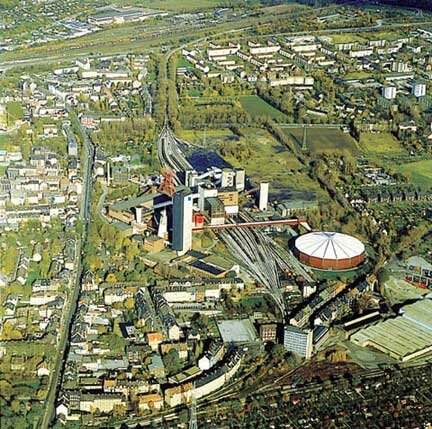 |
Oblique photograph of the Consolidation mine and surrounding areas of Bismarck before closure in 1995 (Source: Gelsenkirchen Municipality. Office for Urban Development and Economic Promotion ) |
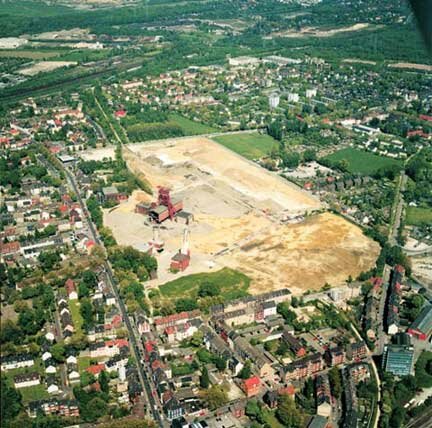 |
Oblique photograph of the Consolidation mine after demolition (Source: Gelsenkirchen Municipality. Office for Urban Development and Economic Promotion) |
2. Main Problems and Development Potential 
One of the main problems is the marked decline in the population of the programme area (currently 18,600) which has been going on for years now owing to deindustrialisation. 19% of the local population - the highest proportion within Gelsenkirchen - are foreigners (some 75% of Turkish origin) and much younger than the German population. Local child-care institutions and schools - in some classes more than 70% of the children are of foreign origin - therefore have to make considerable efforts to achieve integration.
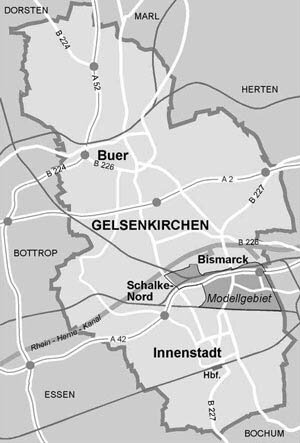 |
Model area location in the city (Source: ILS, Dortmund) |
The closure of large local industrial enterprises over the past decades is also reflected in the 18% unemployment rate for the area. The share of long-term, non-German, and young unemployed is particularly high. Poor job opportunities for (single parent) women is another problem that has long been neglected. High unemployment and the concomitant drop in purchasing power have, moreover, generally weakened local business and the retail trade.
People live together without open conflict but often there is marked distance between them. Relations between old-established residents and new arrivals, between Germans and non-German groups, but also between the different foreign groups are sometimes tense. This is particularly the case in some small-scale neighbourhoods with a high proportion of migrants from different cultures. In particular, second and third generation migrants (mostly Turks) also have increasing school and vocational difficulties owing to language problems.
Demography and Social-Space
|
Bismarck/Schalke-Nord |
Gelsenkirchen |
|
|
Size |
520 ha |
10 500 ha |
|
Population (2000) |
18 600 |
280 000 |
|
Population decline (19962000) |
4.4 % |
3.9 % |
|
Average household size |
2.5 pers. (1999) |
2.0 pers. (2000) |
|
Number of dwellings |
9 500 (1999) |
140 900 (2000) |
|
Vacant dwelling units |
n.a. |
n.a. |
|
Fluctuation |
n.a. |
n.a. |
|
Housing benefit recipients |
n.a. |
n.a. |
|
Unemployment rate (2000) |
Over 18 % |
16.1 % |
|
Social assistance recipients (2000) |
7.0 % |
6.7 % |
|
Foreign population (2000) |
19.0 % (1) |
13.0% (2) |
|
Population under 18 (2000) |
20.6 % |
18.4 % |
|
Population 60 and older (2000) |
23.5 % |
26.1 % |
|
(1) Turks constitute 78% of the foreign population in the model area. |
||
Bismarck and Schalke-Nord have a wide ranging potential for development. The large derelict industrial sites should be mentioned in particular, although they are currently in oversupply (regionally, as well). The Consolidation mine site, now successfully cleared of hazardous waste or at least secured, offers considerable potential for conversion in the context of diversifying local economic structures. The establishment of new firms on the site is feasible, as well as the expansion or relocation of existing enterprises. The well-preserved mine buildings offer also offer space for new culture industries or socio-cultural amenities. Other ways to strengthen the local economy are to promote small and medium-sized craft and business enterprises, and - with certain reservations - to support "services" and the "ethnic economy."
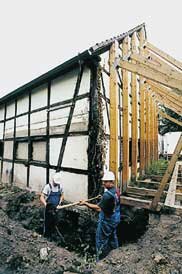 |
Conversion work on the old stable of the Lahrshof (Source: Bismarck/Schalke-Nord District Bureau) |
Positive aspects of the programme area that should not be ignored are its proximity to the inner city and the good transport infrastructure, as well as the associated advantages as a residential location. Also worth mentioning is the range of local social and cultural infrastructural facilities that has increased considerably in recent years (e.g. Protestant comprehensive school, Lahrsdorf Health House, Haverkamp Social Centre), which give important impetus to district life.
 |
Model area location in the city (Source: ILS, Dortmund) |
The historic 150-year-old, listed half-timbered Lahrshof ensemble has been conserved and converted for use by social infrastructure facilities (health centre, day facility for children, youth vocational assistance centre).
3. Development Goals and Focal Points of Action 
On the initiative of the local planning authority, the selection and definition of the programme area for the North Rhine-Westphalian state programme "Districts with Special Improvement Needs" took place in late 1994. On the basis of project proposals from a number of municipal authorities, an immediate programme of measures to be implemented in the short term was initiated (including the setting up of the District Bureau). Early in 1995 a universe of actions was defined and discussed by the competent political and administrative bodies. On 30th March 1995, the Bismarck/Schalke-Nord district programme was finally adopted by the Gelsenkirchen city council as the conceptual basis for urban renewal measures over the coming years. In the course of the renewal process, the 1995 plan of action was further developed. The leeway offered by the state programme with regard to the involvement of various actor groups and the interlinkage of different areas of action has been systematically used and filled with content.
Urban Renewal and Development Goals for Bismarck/Schalke-Nord
|
|
Rehabilitation and recycling of the Consolidation site; |
|
|
Building of the Protestant comprehensive school; |
|
|
Promotion of the local economy (creation of jobs, establishment of new and stabilisation of old enterprises); |
|
|
Establishment of additional employment and training measures (embedded in the various projects of the programme). |
|
|
Upgrading of Bismarckstraße as a shopping street; |
|
|
Spatial integration of dwelling and working (e.g., on the Consolidation site); |
|
|
Improvement of the housing stock and creation of new housing; |
|
|
Improvement of the residential environment; |
|
|
Conversion of accommodation for the homeless into regular social-welfare housing; |
|
|
Improvement of the social and cultural infrastructure and social aids; |
|
|
Interlinking of existing activities and services (including opening up schools, day-care nurseries, and other public facilities, and the coordination of local groups and associations); |
|
|
Resident activation through neighbourhood and outreach social work; |
|
|
Resident participation in project planning and implementation. |
Characteristic element of the cross-authority district programme, which is based essentially on resident involvement and the networking of actors, are, besides reactivation of the Consolidation site, comprehensive regeneration projects with the targeted inclusion of employment and training measures. An important role is also played by the development of the local economy, the improvement of the social and cultural infrastructure, and the coordinated implementation of various social-integrative projects.
Instead of following a spelled-out model or a transparent strategy, renewal in Bismarck/Schalke-Nord is based more on a sort of overarching planning philosophy among the relevant project actors. It is characterised by a common understanding of certain qualities and standards in integrated district renewal, which are to be taken into account in developing individual projects. In particular, urban (district) development must:
- proceed in small steps using endogenous resources;
- be based on resident and social-space oriented strategies;
- be oriented essentially on the development of local partnerships.
4. Key Projects 
Since 1995, a wide range of measures and projects have been initiated in Bismarck/Schalke-Nord with the help of extensive public and private funds - DM 126.8 million between 1995 and 1999 alone. The following overview gives an impression of what has been done. Three of these projects have a strategic function for the district programme: the recycling of the Consolidation mine site, the building and operation of the Protestant comprehensive school as district school, and the redesign and upgrading of Bismarckstraße. These "pilot projects" are supplemented by a combination of numerous, often small-scale measures, largely involving building investment, social integration, or business promotion. In addition, there are process management, resident participation, and public relations measures, which primarily concern procedural aspects. One key to success for the district programme is that over the years it has been continuously broadened and modified - not least of all through the commitment of a wide spectrum of local actors.
Selected Projects in Bismarck/Schalke-Nord
|
since 1995: |
Conversion of the former Paulstraße school into a project house accommodating the offices of the District Bureau (extended to include a migrant centre in 2001/02); |
|
since 1995: |
a wide range of integrated employment and training measures with about 100 - 150 participants per year; |
|
since 1995: |
many urban renewal measures with resident participation (including building and courtyard programme, improvement of the traffic situation in residential areas); |
|
since 1995: |
opening of three municipal child day-care facilities for activities organised by residents; |
|
since 1996: |
JULIUS B project ("JUng sein und Leben In Unserem Stadteil Bismarck/Schalke-Nord": "Young and Alive in Our Neighbourhood Bismarck/Schalke-Nord"); |
|
since 1996: |
participatory school playground programme for the ecological redesign of six school playgrounds; |
|
19961997: |
project of the Emscher Park IBE: "Simple and Do-It-Yourself Building" in Laarstraße with 28 self-help houses; |
|
since 1997: |
language help in day centres for children and in primary schools; |
|
since 1997: |
participatory playground programme for the remodelling of various playgrounds; |
|
19972000: |
conversion of the listed half-timbered building Lahrshof into the Bismarck Health Centre with day care-nursery and youth advice bureau; |
|
19971999: |
IBE project new Bismarck Protestant comprehensive school; |
|
since 1998: |
Office for Economic Development (BfW) to support the local economy; |
|
19982000: |
conversion of the Adamshof municipal shelter for the homeless into regular social-welfare housing; |
|
1999: |
building of the Haverkamp Social Centre by ecological construction methods; |
|
19992000: |
building of the first solar energy estate in the Ruhr District, 70 houses in Bramkampstraße; |
|
since 1999: |
conversion of the listed buildings on the Consolidation mine site 3/4/9 for various theatre and cultural facilities; |
|
since 1999: |
social work and establishment of a residents' centre in Schalke-Nord. |
A central point of departure for the integrated plan of action was the planned revitalisation pf the Consolidation mine site - a major project of considerable political importance for the city as a whole. Owing to the dimensions and complex interests to be taken into account, the realisation of this project naturally took a relatively long time. Meanwhile, however, the different project ideas have successfully been brought together in a practicable framework plan in the course of a laborious coordination process between the local planning authority and the District Bureau on the one hand and Montan Grundstücksgesellschaft (MGG) and Ruhrkohle AG, the owners of the land, on the other. A broad spectrum of uses is planned, with housing construction, recreational amenities (sports facilities, district park), commerce, a specialized discount store and a supermarket, a mosque, and various cultural and culture industry uses. Landmark buildings worthy of protection, like the Shaft 9 tower and pithead are to be preserved.
 |
A ventilator machine building at the former Consol mine was converted by the "forum kunstverein" into a children's and youth theatre with restaurant and café. (Source: District Bureau Bismarck/Schalke-Nord) |
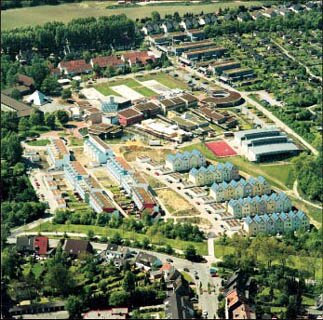 |
Aerial shot of the Protestant comprehensive school with the adjacent housing projects "Bramkampstraße Solar Estate" and "Simple and Do-It-Yourself Housing" in Lahrstraße. The new comprehensive school is a forward-looking project in many regards. (Source: District Bureau Bismarck/Schalke-Nord) |
The second pilot project of the district programme is the building and operation of the Gelsenkirchen-Bismarck Protestant Comprehensive School. This multicultural and ecological school has been constructed in a project that has been innovative in a number of ways. The building, which was opened in 1998 - an IBE Emscher Park project - is based on an architectural concept that draws on the latest ecological standards and provides for opening the school to the local population. The premises, which to some extent were planned and built with the participation of children, parents, and teachers, also serve as a cultural centre and public social centre for the district.
In contrast the two preceding pilot projects, the planned redesign of Bismarckstraße has been of secondary importance in the urban renewal process to date. Apart from the technical redesign of the street, urban development measures are also planned, which are to establish a link between existing neighbourhoods and the future district centre on the adjacent Consolidation site.
In addition to the three pilot projects, the strengthening of the local economy plays a prominent role in the district programme. Against this background, the Office for Economic Development (BfW) was set up in 1998 in the context of a North Rhine-Westphalian government model project as a local agency of the Office for Urban Development and Economic Development. The work of the office focuses on low-threshold consultancy and support for local firms - especially small and medium-sized retailers, craft and service enterprises - the promotion of business start-ups, and the development of lasting networks and cooperation between business actors.
5. Organisation and Management 
|
The key actor in the programme area is the Bismarck/Schalke-Nord District Bureau set up in May 1995 as the local contact point and coordinating office. The local planning authority is responsible for the facility. A solution relatively close to the administrative authorities has thus been chosen for the decentralised project management. It could conceivable also have been placed in the hands of charitable organisations, associations, or other non-governmental organisations. However, care has been taken in Gelsenkirchen to grant the District Bureau enough autonomy from the regular administrative authorities to allow projects and ideas to be realised in the programme area independently and in the short term. In comparison with similar institutions, the Bismarck/Schalke-Nord District Bureau also has a comprehensive understanding of district management, for, apart from its functions in networking local actors and involving residents, it is also concerned with programme planning, project development and coordination, and handling public grants. |
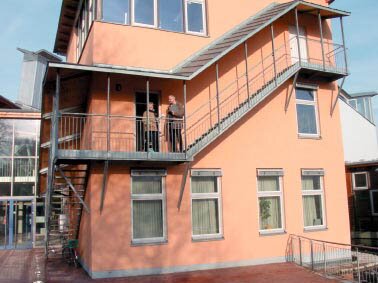 |
The Bismarck/Schalke-Nord District Bureau (Source: Bismarck/Schalke-Nord District Bureau) |
The District Bureau works together with two other intermediary actors operating in the programme area, the Office for Economic Development (BfW) and the JULIUS B project ("JUng sein und Leben In Unserem Stadteil Bismarck/Schalke-Nord": "Young and Alive in Our Neighbourhood"), which operates under the aegis of the Bauverein Falkenjugend. Julius B. concentrates on social work with children and adolescents and on the networking of social integration projects in the district programme.
The annual project control meetings are important for top administration strategic planning for the area. The district programme is coordinated at these meetings between the state, administrative district, and municipal levels. Furthermore, coordination within the administration takes place in a cross-authority working group, which meets once a year. All decisions relating to the district programme on the focus of action, on projects, finance, and contracts are prepared by the District Bureau. The decisions themselves are made either by the competent head of department, the administrative board, or the political bodies of the municipality, depending on how important they are. The preparatory documents for the plan of action (applications for support) are discussed once a year by the district council and city council committees, and are finally adopted by the city council.
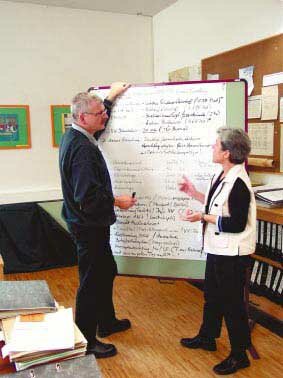 |
The Bismarck/Schalke-Nord District Bureau is the hub of local urban renewal activities (Source: Bismarck/Schalke-Nord District Bureau) |
Within the municipality a number of offices and department are involved in the planning and implementation of the district programme (1). Besides the controlling local planning office, the principal institutions involved are the child welfare office and the office for urban development and economic promotion (including the employment promotion coordinating office). Then there are the offices for culture, school administration, real property, green spaces, transport and health, which are also involved in the renewal process as project developers or agencies, employers or contracting authorities. In addition, various administrative actors take part in working parties and round tables addressing certain topics, target groups, and neighbourhoods, and in project and construction discussions, depending on their specific spheres of competence. One purpose of these discussions is to coordinate various projects and measures with representatives of resident groups, political authorities, supporting organisations, and other societal groups.
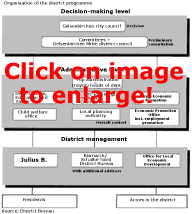 |
Organisation of the district programme (Organigramm) (Source: District Bureau) |
The central area-related body in which the administrative authorities regularly meet with district actors for more general discussion is the "Bismarck/Schalke-Nord Working Party," which has accompanied the programme from the outset. This circle, which comes together more or less quarterly, and which is chaired by the District Bureau, assembles private social work organisations, associations, members of the city and district councils, the competent administrative units, and other relevant actors and institutions from the two suburbs. The working party serves primarily as a forum for the exchange of information, e.g., on projects. Preparatory discussions are also held on the district programmes, which have to be reapplied for annually.
6. Activation, Participation, and Public Relations 
Among the most important objectives of the Bismarck/Schalke-Nord district programme are the active involvement of local residents in the renewal process and the establishment of structures supported by residents and actors. For the organisation and implementation of the various activation, participation, and networking measures and for area public relations, the main responsibility lies with the district management. Five conceptual modules are to be distinguished:
- organisation in accordance with a district-related participation and networking approach (especially District Bureau, Julius B. project, Office for Economic Development);
- activation of the neighbourhood (especially "Schalke-Nord Residents' Centre," "Living Haverkamp" action group and social centre, opening of day facilities for children);
- individual projects and subprogrammes with far-reaching opportunities for participation (especially school playground programme, playground programme);
- public information events and hearings (public meeting, etc.);
- cooperative networks with activation and participation functions (especially Bismarck/Schalke-Nord working party, Association Forum and Forum 2000).
A number of participation approaches particularly important for the development of the district are presented below as examples of the modules.
As early as 1995, the "Opening of Child Day Facilities" project, then unique in the country, was launched with the aim of opening the participating facilities outside normal hours to offer the local population additional spatial, recreational, and educational amenities. For this purpose, additional staff was employed in three municipal day facilities whose task it was to establish public neighbourhood centres. These centres - addressing different content and user groups - have since enabled numerous resident-oriented activities (e.g., discussion groups, handicraft groups, Turkish courses, etc.) so that the three day-care facilities have become places of communication and self-determined leisure activities for the neighbourhood. The activities now largely self-sufficient and do not require the assistance of additional staff.
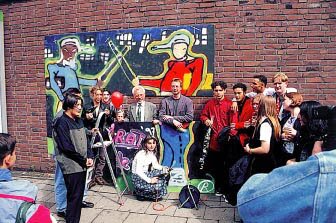 |
Participatory activities in the context of a workshop and playground renewal project in the district are example of the many forms of resident involvement in Bismarck/Schalke-Nord (Source: Bismarck/Schalke-Nord District Bureau) |
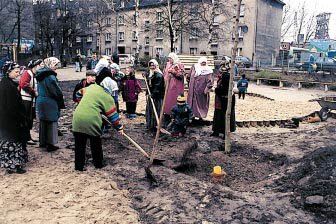 |
The "School Playground Programme" is also among the most important participatory projects. The aim was to remodel the grounds of six schools, and in this manner to initiate social processes that would impact the district over and beyond the schools. For this purpose a landscape architecture firm was engaged in 1996 to involve school children, teachers, and parents in the planning and construction work by developing tailor-made redesign plans for the grounds of each schools, and to present them for discussion at school celebrations and other joint events. Between 1997 and 1999 the school playgrounds were then remodelled close to nature in the course of integrated employment and qualification measures. In the context of building, greening, and play campaigns the children, teachers and parents were actively involved in this phase.
Among the most important resident-organised structures in the programme area is the umbrella association "Forum 2000 Gelsenkirchen Bismarck/Schalke-Nord," which emerged in 2000 from the informal network "Forum of Associations." The main objective of the forum is to safeguard and develop long-term cooperation between local associations and groups. The tasks of the forum include staging district events and campaigns, networking local associations, civic action and residents' groups, and to convey the interests of both suburbs to the public at large and to promote them vis-à-vis the municipality. The forum, which had already gained 22 members by February 2001, is still backed organisationally by the District Bureau and Julius B., but will in future stand on its own feet.
Among the resident-organised activities that graphically illustrates the positive shift in mood in the programme area are the two big district festivals, which are held annually in Bismarck's Bürgerplatz. They are the "International Christmas Market" and the "Bürgerplatz Party" in late summer. The aims of both events include enhancing the district identity and promoting structures of civic self-organisation. Forum 2000 is responsible for planning and staging. With the help of the District Bureau and Julius B., along with local institutions, members of the forum organise a wide-ranging programme of amusements and entertainment, which attracts an average of between 4,000 and 5,000 residents from the two suburbs.
7. |
Conclusion/Prospects: Stabilising the Successful Development in Schalke-Nord
|
In recent years, local living conditions have tangibly improved in Gelsenkirchen-Bismarck/Schalke-Nord, and new perspectives have been opened up for the people who live there. The crucial conceptual and financial basis for these revitalisation activities has been provided by the NRW action programme "Districts with Special Improvement Needs" and the "Socially Integrative City." A considerable amount of private capital was also attracted for investment in district development: for example, there has been considerable investment in new housing construction and in the building and school playground programme. The success achieved owes a great deal to the commitment and cooperativeness of local actors from clubs and associations, organisations, civic groups, private sponsors, the administrative authorities, public institutions, parishes, and political institutions. The majority of activities they have been realised in recent years would not have been possible without the work put in by these paid and unpaid contributors.
However, despite the justified satisfaction with what has been achieved to date, it is far from certain whether the positive developments will be sustained in the long run. All the more so because support for the district programme from the federal and state governments is highly likely to end after 2004, and the available funds are to be progressively reduced up to that date. The remaining years of the programme must therefore be used primarily to establish political and organisational framework conditions to ensure the sustainability of the quality and success of the regeneration process even after the government programmes have come to an end. Important questions need to be answered:
- What goals and models are available for the development of Bismarck/Schalke-Nord beyond the district programme? ("Development perspectives")
- How can resident-organised structures be strengthened to allow important district-related activities to be taken over in the long term by resident groups? ("Empowerment")
- How can the resources of the regular administrative authorities be used to greater effect than hitherto to stabilise and develop Bismarck/Schalke-Nord (and other disadvantaged urban areas)? ("Spatial orientation of administrative action")
- What activities/functions of the district management should be maintained after the end of the district programme in order to stabilise the regeneration process? What organisational and financing forms are conceivable in this regard? ("Aftercare of the programme area")
- What experience gathered in Bismarck/Schalke-Nord should be used for future district programmes in Gelsenkirchen? ("Experience transfer")
Regardless of the specific answers to these questions, in the coming years it will be necessary in Bismarck/Schalke-Nord and other "Districts with Special Improvement or Development Needs" to transform the integrated district development approach from an exotic "special project" into a lasting, high-priority, and citywide area of political and administrative action. Only then will the societal integration of all city residents be ensured and the social and spatial exclusion of individual population groups prevented.
References
(1) On 1st April 2001 preparations for an administrative reform got under way in Gelsenkirchen with an initial and trial phase. In the course of introducing the "New Control Model," departments (Dezernat) and offices (Amt) were restructured into "management areas" (Vorstandsbereich), "specialist areas" (Fachbereich) and "sections" (Referat). For better understanding, the accustomed terms "department" and "office" are used in this chapter. ![]()
Im Auftrag des BMVBS vertreten durch das BBR. Zuletzt geändert am 25.05.2005